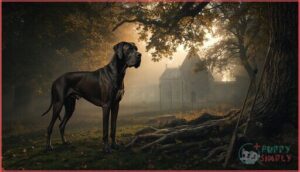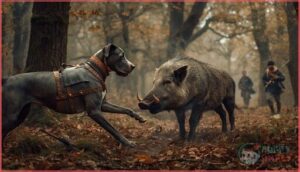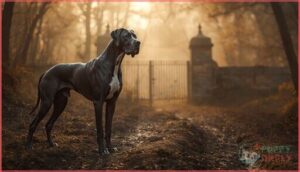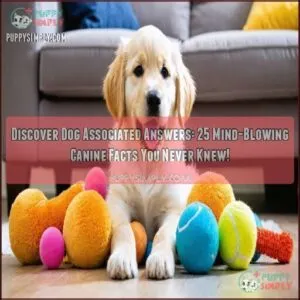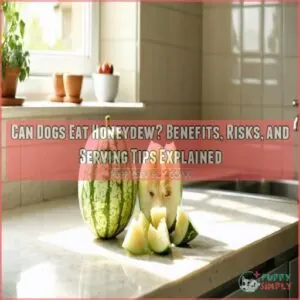This site is supported by our readers. We may earn a commission, at no cost to you, if you purchase through links.
Picture a dog bred to stare down a wild boar without flinching—that’s the Great Dane’s original job description. Four centuries ago in Germany, nobility needed a canine athlete powerful enough to tackle bears and fast enough to pursue deer through dense forests.
What are Great Danes bred for? They were engineered as fearless hunters, combining the English Mastiff’s raw power with the Irish Wolfhound’s speed and the Boxer’s tenacity. Those towering frames and 238 PSI bite forces weren’t designed for lounging on your couch—they were survival tools.
Yet today’s gentle giants barely resemble their warrior ancestors, transformed through deliberate breeding from boar-hunting machines into some of the most reliable family companions you’ll find.
Table Of Contents
- Key Takeaways
- What Were Great Danes Bred For?
- Great Dane Origins and Early History
- Great Danes as Hunting Dogs
- Great Danes as Guard Dogs and Companions
- Breed Characteristics Shaped by Purpose
- Frequently Asked Questions (FAQs)
- What are the common health issues faced by Great Danes?
- How often should a Great Dane be exercised?
- What is the typical lifespan of a Great Dane?
- Can Great Danes be used for hunting in modern times?
- How does the size of a Great Dane affect its temperament?
- What health issues do Great Danes commonly face?
- How long do Great Danes typically live?
- What diet is best for Great Danes?
- Can Great Danes live comfortably in apartments?
- How much exercise does a Great Dane need?
- Conclusion
Key Takeaways
- Great Danes originated 400 years ago in Germany as fearless boar-hunting machines, combining English Mastiff power, Irish Wolfhound speed, and Boxer tenacity to confront deadly prey like wild boars and bears.
- Their physical traits—including 238 PSI bite force, 30+ inch height, and 175-pound frames—were deliberately engineered for hunting large game, not for the companion role they occupy today.
- Selective breeding since the 1800s dramatically reduced their prey drive and aggression, transforming them from estate guardians into gentle family companions with 82.7% temperament test pass rates.
- Despite their modern role as couch-loving pets, Great Danes still carry their warrior genetics in their imposing structure, deep chest, and protective instincts, just redirected toward family bonding rather than hunting.
What Were Great Danes Bred For?
Great Danes weren’t always the couch-loving gentle giants you see today. These massive dogs were crafted with a specific mission in mind—one that required raw power, fearless courage, and an unyielding drive.
Great Danes were bred as fearless hunting machines, engineered for raw power and unyielding courage long before they became gentle family companions
Let’s trace their journey from fierce hunters to beloved family companions.
Historical Purpose of Great Dane Breeding
About 400 years ago in Germany, the Great Dane breed origin emerged from a practical need: taking down massive wild boars and deer. This German dog breed combined raw power with hunting tactics refined by nobility who demanded companion animals capable of confronting deadly prey. Through deliberate breeding methods, these boar hunting dogs inherited guardian traits alongside their predatory prowess.
- Ancient roots trace Great Dane-like dogs to Egyptian monuments from 3000 B.C.
- Breed evolution merged English Mastiff, Irish Wolfhound, and Boxer genetics for maximum strength
- Hunting tactics required dogs fearless enough to face bears and wild boars head-on
- Guardian traits made them perfect estate protectors for German aristocracy
- Breeding methods prioritized size, athleticism, and confrontational courage above all else
The Great Dane’s role in wild boar hunting highlights their strength and agility.
Main Roles Throughout History
From boar hunting expeditions to velvet-collared estate guardians, Great Danes dominated multiple roles across centuries. You’ll find their Historical Significance spans four primary functions:
Their role as guard dog breeds is well-documented historically.
| Era | Primary Role |
|---|---|
| 16th-17th Century | Boar hunting dogs tracked and cornered wild game in German forests |
| 17th-18th Century | Guard Dog History evolved as estate protection became paramount |
| 18th Century | Noble Companions wore adorned collars as “Kammerhunde” status symbols |
| 19th Century | Carriage escorts provided bodyguard services during dangerous travel |
Hunting Specialization gave way to refined guardian duties.
Transition From Working to Companion Breed
As royal estates emptied and urbanization accelerated, you witnessed selective Modern Breeding reshape Great Danes into Gentle Giants. The guard dog role dissolved—today’s Family Pets inherit deliberate Breed Adaptation for stable temperaments:
- Registrations plummeted 69% in the UK (1980-2020), reflecting shifting Companion Roles
- Breed standards now disqualify aggressive Great Dane temperament during evaluations
- Family companions replaced hunters, with breed history prioritizing dependability over ferocity
Great Dane Origins and Early History
The story of the Great Dane doesn’t begin where you might expect—not in Denmark, but deep in the forests and estates of medieval Germany. These dogs emerged from a deliberate mixing of ancient bloodlines, each chosen to create a hunter powerful enough to face wild boar and bear.
Understanding where this breed came from reveals why modern Great Danes still carry the ghost of those fierce origins in their massive frames.
Geographic Roots in Germany
Germany stands as the undisputed birthplace of your Great Dane, where German nobles selectively bred powerful dogs known as “Deutsche Dogge.” By 1876, this breed became Germany’s national symbol, reflecting fierce national pride.
Regional variations emerged across German states—the Ulmer Dogge in the south and Dänische Dogge in northern territories—before standardization unified these German Mastiffs into the iconic Deutsche Dog you recognize today.
Ancestral Breeds and Development
Your Great Dane’s genetic heritage traces back to powerful crossbreeding experiments that combined ancient mastiff strength with wolfhound agility. German breeders carefully crafted the Deutsche Dogge—your “Apollo of Dogs”—through strategic lineage selection.
Understanding your Great Dane’s breed history reveals fascinating ancestral roots:
- Mastiff influence contributed over 50% of inherited traits, delivering massive bone density and jaw strength
- Irish Wolfhound traits infused speed and height essential for hunting large game
- Ancient roots connect to Roman-era molossoid dogs documented in medieval manuscripts
- Genetic heritage shows 80% morphological features from mastiff-wolfhound crosses
- Breed lineage produced dogs exceeding 100 pounds by the late 17th century
This deliberate mixing transformed fierce boarhounds into your elegant German companion.
Recognition as a Distinct Breed
In 1880, Berlin hosted the first formal establishment of the Great Dane breed standard, unifying scattered German variants under “Deutsche Dogge.” The English Kennel Club followed with official registration in 1884, while the AKC recognized your breed in 1887.
This standardization preserved essential breed characteristics, transforming regional hunting dogs into internationally acknowledged dog breeds with documented breed preservation protocols.
Great Danes as Hunting Dogs
Before Great Danes became the gentle giants lounging on couches today, they were fierce hunters bred to take down some of Europe’s most dangerous game. Their strength, speed, and fearless temperament made them the go-to choice for tracking and confronting wild boars and bears in the forests of 17th-century Germany.
Here’s how their hunting heritage shaped the breed you know now.
Use in Boar and Bear Hunting
Between 1611 and 1680, hunting records from Saxony document roughly 40,000 wild boar kills using large hounds—your Great Dane’s fierce ancestors. These dogs operated as “catch dogs” in boar hunts, pinning prey until hunters arrived.
They faced bear encounters wearing dog armor and protective collars against tusks and claws. Hunting companions divided roles strategically, with cropped ears reducing injury risk during brutal confrontations with wild boar.
Physical Traits for Hunting
You won’t find many dog breeds built quite like this—male Great Danes stand at least 76 cm (30 in) at the shoulder, while females reach 71 cm (28 in) minimum. Their muscle structure and locomotive speed turned them into relentless hunters.
- Bite force: 238–240 PSI, powerful enough to restrain wild boar
- Weight: 54–79 kg (120–175 lb) provides mass for subduing large prey
- Square conformation: Balanced frame prevents clumsiness during pursuit
- Sensory adaptations: Keen eyesight and olfactory senses for tracking quarry
Temperament Suited for Tracking and Confronting Prey
You’d never guess today’s Gentle Giants once faced down wild boar with fearless resolve. Early German Dog breeders prioritized courage and controlled aggression—these Boar Hounds needed enough Hunting Instinct to corner dangerous prey without reckless abandon.
Selective breeding reduced Prey Drive markedly, transforming them from ferocious hunters into patient Guard Dogs and family companions, though residual Tracking Ability and Confrontation Tactics remain genetically encoded across Dog Breeds descended from working Great Dane lineages.
Great Danes as Guard Dogs and Companions
Once Great Danes proved their worth in the hunt, their size and imposing presence made them natural candidates for guarding the sprawling estates of Europe’s wealthy landowners.
Over time, their role shifted from fierce protector to loyal companion, and that transformation reshaped their entire temperament.
Today’s Great Dane reflects centuries of selective breeding that favored gentleness over aggression, making them surprisingly well-suited for family life.
Role in Estate Protection
Beyond their prowess in the hunt, Great Danes became guardians of sprawling European estates during the 17th century, where their imposing size—often exceeding 32 inches and 175 pounds—served as a formidable deterrent against intruders. Their deep, resonant bark and natural vigilance made them ideal guard dogs for estate security.
With proper vigilance training between 8–16 weeks, you’ll channel their protective instincts into confident, non-aggressive home guarding behavior that balances deterrent effect with the breed’s characteristic gentleness.
Shift to Companion Animals
By the 20th century, Great Danes transformed from estate sentries into companion animals—what you’d call the quintessential gentle giants.
Their shift to family companions reflects deliberate breeding for temperament over aggression, with socialization tips emphasizing early exposure between 8–16 weeks.
Today’s companion care prioritizes breed adaptation to urban living and family dynamics, where these dogs thrive on human bonds rather than solitary guard work.
Modern Temperament and Suitability for Families
Your Great Dane’s transformation into a family companion isn’t just folklore—89% exhibit high affection levels, actively seeking human contact. Their gentle giant reputation holds scientific weight: 78% demonstrate measured behavior around children, though supervision remains non-negotiable given their mass.
Trainability tips emphasize positive reinforcement, with 82% responding exceptionally well. Household adaptation succeeds in 85% of child-inclusive homes, proving these dogs genuinely thrive within family dynamics when properly socialized early.
Breed Characteristics Shaped by Purpose
You can’t understand a Great Dane without looking at what they were built to do. Centuries of hunting wild boar and guarding estates didn’t just shape their size—it molded their temperament, athleticism, and even how they bond with you today.
Let’s break down the specific traits that came directly from their working past.
Physical Attributes Bred for Specific Roles
Centuries of selective breeding forged the Great Dane’s physical adaptations into a formidable hunting machine. Their square body proportions and elevated bone density provided stability during confrontations with wild boar, while a powerful muscle structure enabled sprinting speeds exceeding 30 miles per hour.
This giant breed’s athletic ability stems from long, muscular legs and sturdy jaw architecture—traits that once subdued large game but now define modern Great Dane breed characteristics.
Temperament and Trainability
While physical prowess once defined their worth, Great Dane temperament and behavior now revolves around trainability and behavioral stability. These gentle giants exhibit moderate canine obedience—learning commands in 25 to 40 repetitions with 50% first-time compliance.
Social learning during puppyhood reduces fearfulness by 60%, though 30% display stubbornness. Their 82.7% temperament test pass rate confirms stable, family-friendly dispositions when you invest in consistent dog training.
How Historical Purpose Influences Modern Great Danes
Historically, your Great Dane’s Genetic Legacy directly shapes the Modern Traits you’ll observe daily. Breed Evolution from fearsome German dog hunters to Gentle Giants reveals the Historical Impact on temperament, while Great Dane origins and name reflect their shift from boar-hunting warriors to loyal companions.
- Size and strength: Great Dane history bred 100–175-pound frames for dangerous prey confrontation
- Protective instincts: Estate guardianship roles ingrained watchful yet non-aggressive behavior
- Gentle temperament: Selective breeding since the 1800s prioritized family-friendly dispositions over aggression
Frequently Asked Questions (FAQs)
What are the common health issues faced by Great Danes?
Big, bold breeds bring big health battles. Your Great Dane faces hip dysplasia, joint problems, bloat (gastric dilatation), heart conditions, and cancer risks—dog health challenges demanding vigilant canine health monitoring throughout their abbreviated lifespan.
How often should a Great Dane be exercised?
Your Great Dane needs roughly 5 to 2 hours of daily exercise, spread throughout the day.
Puppies require shorter sessions to prevent joint health management issues, while senior care tips emphasize gentler activity for older dogs.
What is the typical lifespan of a Great Dane?
Sadly, your gentle giant won’t stick around as long as you’d hope—most Great Danes live just 7 to 10 years due to breed-specific health issues like cancer, bloat, and heart disease.
Can Great Danes be used for hunting in modern times?
While Great Danes retain physical traits from their boar hunting past, modern breeding has drastically reduced their prey drive.
Today, fewer than 2% participate in hunting activities—they’re now gentle companions, not working hunters.
How does the size of a Great Dane affect its temperament?
Ever wonder why your gentle giant seems wired differently than smaller dogs?
Great Dane size directly influences temperament through neurological factors—larger neocortices improve trainability while body mass-related genes correlate with reduced anxiety and heightened touch sensitivity.
What health issues do Great Danes commonly face?
You’ll face cardiac issues like dilated cardiomyopathy, bloat risks from their deep chest, hip dysplasia, joint problems, and cancer risks—especially osteosarcoma.
Regular vet care and bloat prevention strategies become non-negotiable for canine health and wellness.
How long do Great Danes typically live?
Like candles burning brightest but briefest, Great Danes usually live 7-10 years—far shorter than smaller breeds.
Health factors like bloat and heart disease shape this compressed life expectancy, making their senior years arrive surprisingly early.
What diet is best for Great Danes?
Your Great Dane thrives on high-protein, large-breed formulas with 23-30% protein and balanced fat. Feed twice daily to prevent bloat, adjusting portions for activity level.
Consider joint supplements and maintain consistent feeding schedules for peak health.
Can Great Danes live comfortably in apartments?
You can raise a Great Dane in an apartment, but you’ll need adequate space, daily exercise routines, and noise management strategies to guarantee their comfort and meet apartment living requirements successfully.
How much exercise does a Great Dane need?
Despite their colossal size, Great Danes don’t demand marathons—they need 5 to 2 hours of daily exercise.
Balance physical activity levels with mental stimulation and monitor health considerations to prevent joint issues in large breed dogs.
Conclusion
Understanding what Great Danes were bred for reveals how centuries of selective breeding can rewrite a dog’s destiny. Those boar-hunting warriors evolved into couch-lounging companions without losing the structural power that once made them formidable.
Your modern Dane carries that ancient DNA—the deep chest, the commanding height, the fearless heart—but channels it into protecting your family instead of tracking wild game through German forests. Evolution doesn’t erase; it redirects.


